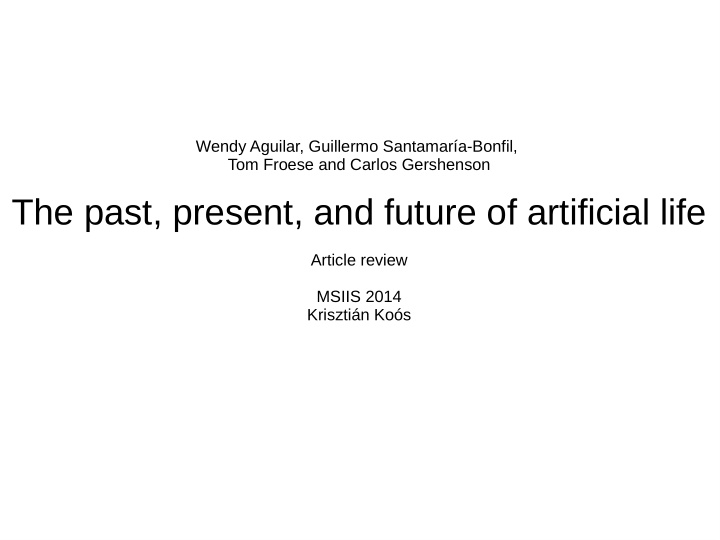



Wendy Aguilar, Guillermo Santamaría-Bonfil, Tom Froese and Carlos Gershenson The past, present, and future of artificial life Article review MSIIS 2014 Krisztián Koós
Emergence of artificial life ● What makes the living different from the non- living? – Trend in mid-1980 – Build life in order to understand it better ● This article reviews artificial life – Classified into 14 themes
The past ● Google for 'artificial life' in time (Ngram Viewer) – Frequency jumps between 1986-1997 – High peek in 1821 – how? ● Frankenstein ● Can we make living creatures? What are the conditions of life? – Creatures in mythology (Greek, Mayan, etc.)
The present 1. What is artificial life? ● Langton: – “life made by man rather than by nature,” - problematic definition – “artificial life” and “biology” should not differ ● Bedau: – interdisciplinary study of life and life-like processes – “Soft”: simulations – “Hard”: hardware – “Wet”: synthesizes living systems from biochemical substances ● ALife: currently it means artificial life
2. Origins of life ● Approaches – Metabolism-first (chemical change in cells) – Replicator-first ● (hen or egg)
3. Autonomy ● ~Self-maintenance ● In robotics – Move and interact – Without depending on remote control ● Degree of autonomy
4. Self-Organization ● Local interactions lead to global behaviors – Traffic, swarms ● Special cases: – Self-replication – Self-maintenance – Self-assembly ● e.g. self-reconfigurating robots ● Recently – Cognitive science – Systems adapting to unforeseen circumstances
5. Adaptation ● Definition – A change – As a response – To fulfill goals ● Adaptation time scales – Low – evolution – Medium – development – Fast – learning
5.1 Evolution ● Genetic algorithms – Searches for a global minimum
5.2 Development ● Some computational models: – Neural networks – Bayesian networks
5.3 Learning ● No agreed definition ● Several approaches in machine learning – Neural networks – Reinforcement learning
6. Ecology ● Interactions – between individuals from different species – with their environment ● ALife ecological models: – Resource management – Land-use
7. Artificial Societies ● Interactions of individuals of the same species ● Topics: – Game theory: prisoner's dilemma – Evolution of language and communication
8. Behavior ● Sense-model-plan-act architecture – internal representations ● Adaptive behavior – contributions of the body and of the environment
9. Computational Biology ● ALife has contributed to theoretical biology with the development of computational models and tools
10. Artificial Chemistries ● Origin of life from chemical components
11. Information ● How the properties of living systems should be measured? – Adaptability – Autonomy – Complexity
12. Living Technology ● Technology that is based on the core features of living systems ● Primary: constructed from non-living components ● Secondary: depends on living properties ● Applications: – cleaning pollution – generating energy – improving health
13. Art ● ALife have been used for creating artwork – Visual arts – Music
14. Philosophy ● Is modeled life a real life? – “strong” and “weak” ALife – the objective results remain the same
The Future ● Many open questions ● Will ALife be considered as “artificial”? ● Movie: “Mechanical Love”
Recommend
More recommend